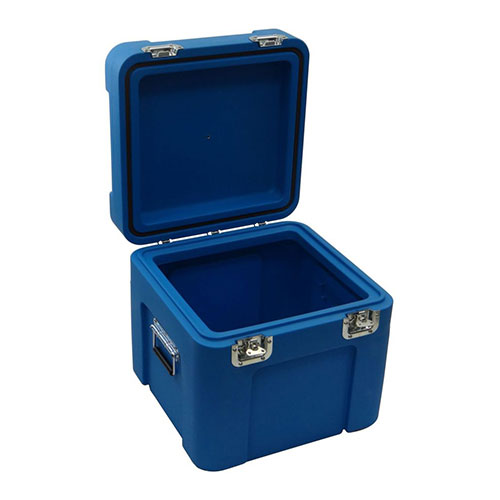Learning & Insight
- What is rotational moulding?
-
Rotational moulding involves the use of computer controlled machines to ensure consistent quality for every unit produced. The plastic rotational moulding process is split into four operations:
1. Charging
The rotomoulding process begins by loading a hollow, aluminium mould with a pre-determined amount of powdered polymer, typically polyethylene and virgin or recyclable material. The mould is then closed, locked and loaded into an oven chamber.2. Heating
Once inside the oven, the mould is rotated biaxially (ie. around 2 axes). The temperature of the oven, typically between 260°C – 370°C depending on the material used, causes the polymer to melt. As the mould rotates, the molten polymer is dispersed evenly and coats the inside walls of the mould.3. Cooling
After the mould has been rotated sufficiently to spread the molten polymer evenly, it is then removed from the oven and cooled, causing the polymer to solidify.4. Unloading
When the mould has cooled sufficiently to retain its shape, it is opened and the product removed. The mould can then be reloaded and the rotomoulding process repeated. - What is rotational moulding used for?
-
A wide range of everyday items are made using rotational moulding due to its versatility as a manufacturing process. Wheelie-bins and litter bins, car dashboards and cup holders, aeroplane components, cones and road barriers, and children’s toys are just some of the products that are make using rotomoulding.
At Trifibre, rotational moulding is used to manufacture our exhibition cases and point of sale stands, including products for Salem & Senior Design. The resulting products are lightweight, ensuring they can be easily transported, and incredibly strong to protect the contents, which may include roller banners or product samples. We also add hinges, clasps and wheels for greater usability.
Take a look at various components that are used to make the Trifibre Pegasus case a useful piece of kit for exhibitions and events. Contact us for a rotational moulding quote.
- What are the advantages of using rotational moulding?
-
Rotational moulding can be used to make a wide range of plastic products that require a rigid and highly resilient finish. It is recognised as being a highly versatile and reliable manufacturing process because it reduces internal stresses by providing a consistent finish through an even distribution of materials and eliminates the need for joints.
Strength and resilience
Products that are manufactured using rotational moulding do not have seams or joins, so they can withstand more extreme conditions than those made using fabricating, fibre glass, injection, vacuum or blow moulding.Precision
Computer Aided Design (CAD) software is used to create designs that are completely accurate. It helps to streamline the design and manufacturing process and improves the overall quality of the final product.Affordability
Rotomoulding is ideal for projects that require an affordable manufacturing process, as moulds are created using cost-effective materials such as aluminium.Lightweight products
It is a popular manufacturing process for products that need to be lightweight and user friendly, but also strong enough to withstand external pressure or weight. It’s an ideal solution for making hollow products, such as water containers, kayaks, floats and buoys.Detailing
Individual moulds are custom made for each project and can incorporate a range of details, including textured finishes, brand logos, symbols or other lettering. - What materials are used in rotational moulding?
-
At the start of the process, metal moulds are created using aluminium, while the final product is made from polyethylene, polypropylene, polyvinyl chloride (PVC), nylon or polycarbonate.
At Trifibre, we use a powdered polymer, usually polyethylene and virgin or recyclable materials, to make products using rotational moulding. Polyethylene is an ideal material for the rotomoulding process as it does not deteriorate when exposed to extreme heat, enabling it to be easily melted and manipulated into a range of shapes and items.
- How does rotational moulding work?
-
Rotomoulding is a thermoplastic moulding process that involves four key processes: charging, heating, cooling and unloading. As a largely automated process, rotomoulding can improve production times while producing high quality items.
Computer Aided Design (CAD) software is used during the development process to create accurate product designs and complex shapes. It can also predict how a product may react to external factors, such as extreme temperatures.
At Trifibre, CAD software also enables us to calculate weight and volume for accurate material usage and accurate quotes.

Rotational Moulding: 10 Essential Tips for Successful Product Design
Dec 21, 2023

How to Determine the Ideal Products for Rotomoulding
Nov 21, 2023

The Benefits of Rotomoulding
Nov 14, 2023

All Systems Go! On new large Rotational Moulding Machine
Nov 14, 2023


